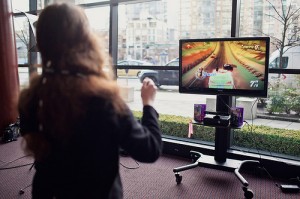SIEGEL: Let's start with Cassee. First of all, how did the two of you come up with this idea?
CAIN: Well, Ziyuan and I have been friends for about four years now and we've had a lot of the same classes together and I've always been really interested in the medical field and Ziyuan has always been interested in computer science. And one day, he was at my house playing the Kinect. We were kind of curious how the Kinect could see and critique our dance moves and so this was just something that we were both really interested in and it kind of sparked our interest in this field.
SIEGEL: In a nutshell, how does it work?
LIU: Well, the Kinect actually has two cameras and a laser emitter, so the laser emitter scatters little laser dots around the environment and that one of the cameras senses the distortion in these laser dots to measure depth and the other camera takes in the picture of the environment and correlates that with the depth.
And with that, we're practically able to reconstruct the environment in 3D, but our project focuses on extracting certain points like joints, knee angles.
CAIN: So, for our project, because we were interested in the way that people are walking, so we tracked the hip, the knee and the ankle and, just by tracking those three points, we were able to find the knee angle, which is really useful for therapists and clinicians and prosthetists when not only fitting prosthetics, but also helping people with therapy and rehabilitation.
SIEGEL: Well, take us back to your - after the moment when you decided this was a project you might do, how did you go about doing the project and how much study did you both have to do to apply the Kinect to this problem you'd identified?
CAIN: Actually, as soon as school got out for the summer, we began working at the Oakridge National Lab and went in to work about eight hours a day. We had to learn computer programming languages, but it also took a lot of learning about the background and how we could even apply this project.
So we learned a lot about gait analysis and that field and the work that's been previously done and also about future applications, as well as the computer side.
SIEGEL: What strikes me as so remarkable here is that, nowadays, the typical household might have something like a Kinect in it which is a phenomenal piece of technology. What you found was an interesting way of applying that technology, but it's in millions of homes all over the country.
CAIN: Yeah. This is a device that you can go buy at Walmart and take out of the box and use, so it really adds to the portability and accessibility of this device and also the affordability.
SIEGEL: Did you look, Ziyuan, at the kind of machinery that this might be replacing and how much more expensive it is than what you were working with?
LIU: Oh, yeah. Oh, yes. Actually, we did research replays from the stereo cameras and those cost usually around $2,000 each and the Kinect - it's many, many more times more affordable.
SIEGEL: So if this gets around, you know, the two of you are going to be cited by a million kids as they tell their parents, no, I'm not just playing with the Kinect. It's my science project.
CAIN: That's actually how I got my parents to buy me the Kinect.
LIU: Same here.
The transcript was originally posted on NPR.


